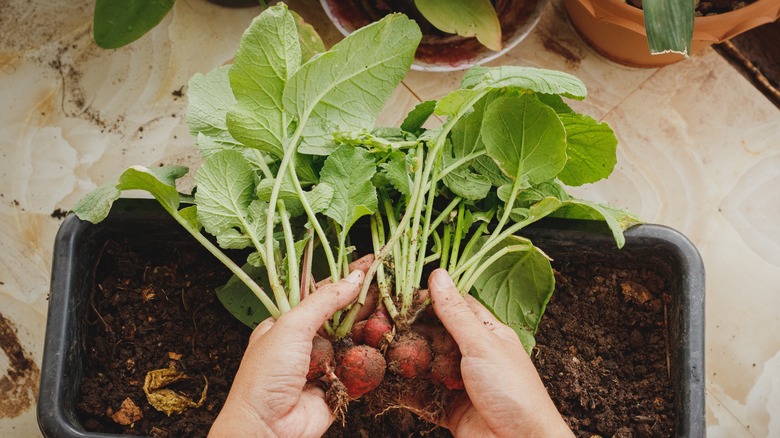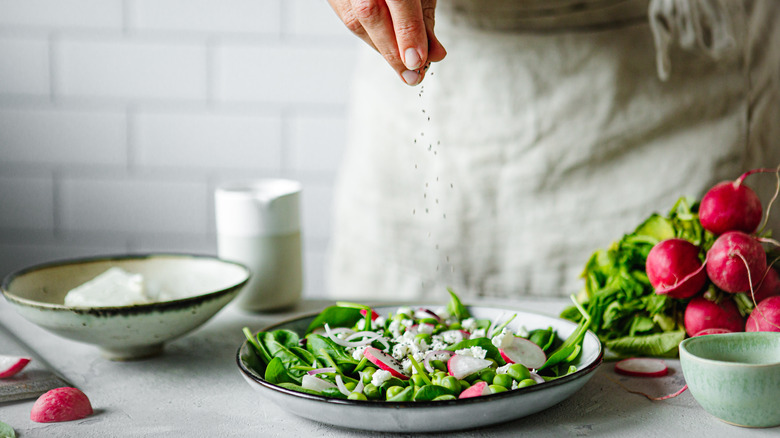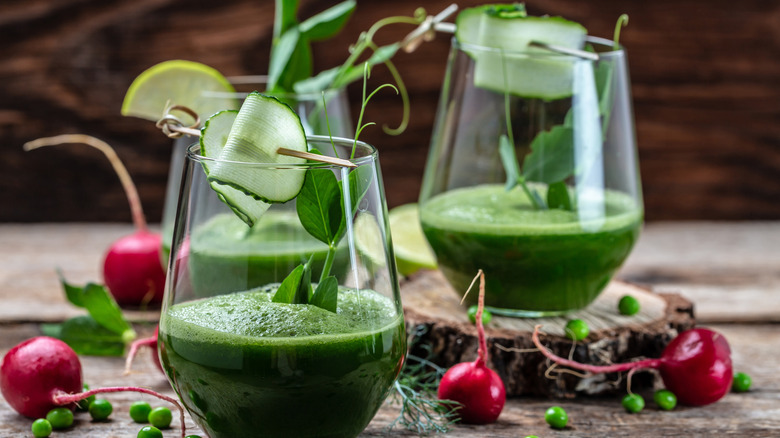Radish Greens Are Totally Edible. Here's How To Prepare Them
Radishes can be a delicious choice for salads, nachos, or grain bowls, adding color and flavor to the final dish. Their leaves are edible, too, and pack a hefty nutritional punch. A handful of radish greens provides 12% of the recommended daily vitamin C intake, 8% of the recommended daily amount of vitamin A, and quite a lot of iron, calcium, and B-complex vitamins. You'll also get large doses of quercetin, an antioxidant with cardioprotective, anti-inflammatory, and anti-cancer effects.
These nutritious greens can taste pretty amazing, depending on how you prepare them. They're a great addition to pasta dishes, stir-fries, soups, curries, pesto, and everything in between. You can also mix them into smoothies or use them as a substitute for lettuce in salads, sandwiches, or grilled turkey wraps. For a quick snack, drizzle them with a bit of olive oil and balsamic vinegar, add a pinch of salt, and top with grated parmesan.
When preparing radish greens, there are a few things to remember before you start cooking. For starters, you'll want to snip the greens and store them separately immediately — they tend to wilt quickly. You should also rinse them thoroughly to remove any dirt or grit (you may even want to dunk them in water before drying).
How to eat and cook with radish greens
Radish greens are slightly bitter, with an earthy, peppery flavor. They taste similar to mustard greens or arugula and can add a spicy note to salads and other dishes. Some people prefer to eat them raw, while others will steam, braise, or fry them. For example, making braised radish greens with grilled chicken strips requires cooking the leaves in a pan for a few minutes, while smooth and creamy radish top soup calls for simmering them slowly. Just like spinach, they'll become softer and less bitter when cooked.
You can also try making a salad with raw radish greens, cherry tomatoes, walnuts, mozzarella or feta cheese, and a zesty vinaigrette. Consider adding olives or capers for a more intense flavor. Another option is to sauté the radish greens with other vegetables and chicken, turkey, or beef for a quick lunch or dinner. If you're craving a frittata or quiche, add chopped radish greens to the mix. Alternatively, stir them into a creamy risotto or rice bowl for a pop of color.
The greens are also prized by professionals. Dino Luciano, the winner of MasterChef Season 8, pairs beet hummus with pickled asparagus, radish greens, and pecorino cheese. The greens add a subtle spicy kick to the dish, while the cheese balances the flavors. Other chefs prefer grilling radish greens for their crispiness, serving them with ricotta, butter, and seasonings like fresh herbs. The greens can also be pickled and then used in sandwiches or wraps.
Add radish greens to smoothies for a nutritional boost
Radish greens are a nutritious addition to vegetable juices and smoothies. Not only are they higher in vitamin C, calcium, and protein than the roots, but they also contain four times more flavonoids and two times more phenols, according to 2019 research published in the journal Nutrients. As the scientists note, these compounds may protect against diabetes, cancer, and liver disease.
The problem is that cooking may destroy some of the nutrients in radish greens and other vegetables. "Antioxidants are sensitive to heat," explains Jennie Chen, a dietetic intern at the Frances Stern Nutrition Center. For this reason, it's often better to consume raw or steamed greens, which preserve their nutritional value.
Start with your favorite green smoothie recipe and add radish greens to the mix. Alternatively, substitute radish greens for spinach, kale, or romaine lettuce. On a similar note, you can add these greens to raw soups, cold noodle salads, dips, spring rolls, or other dishes that don't require cooking. If you find them too bitter, mix them into hummus or vegetable purees to mask their flavor.


